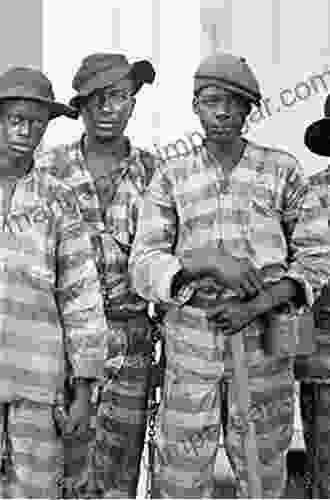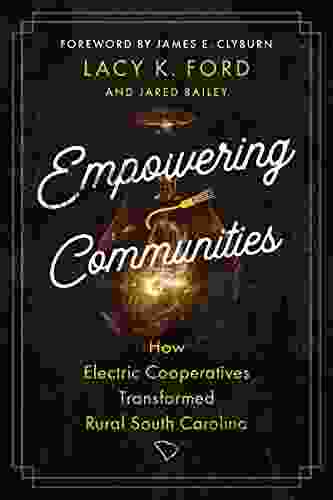How Electric Cooperatives Transformed Rural South Carolina: A Journey of Progress and Empowerment

In the early 20th century, rural South Carolina was a vast tapestry of isolated and impoverished communities. Darkness enveloped the nights, and the lack of electricity hampered all aspects of life. But from the depths of adversity emerged a beacon of hope—electric cooperatives. These locally owned and operated utilities brought the transformative power of electricity to the countryside, forever altering the landscape of South Carolina.
5 out of 5
| Language | : | English |
| File size | : | 2603 KB |
| Text-to-Speech | : | Enabled |
| Screen Reader | : | Supported |
| Enhanced typesetting | : | Enabled |
| Word Wise | : | Enabled |
| Print length | : | 232 pages |
The Dawn of Rural Electrification
The first electric cooperatives in South Carolina were established in the mid-1930s, as part of the Rural Electrification Act. This federal legislation provided low-cost loans and technical assistance to communities seeking to establish their own electric utilities. In the early days, progress was slow and arduous. Co-ops faced resistance from established power companies, who feared competition for their lucrative urban markets. But undeterred, rural residents banded together, pooling their resources and their determination.
Overcoming Obstacles
The challenges faced by these early co-ops were immense. They had to string miles of power lines across rugged terrain, often through swamps and forests. They had to overcome resistance from landowners who were reluctant to allow co-op lines to cross their property. And they had to educate their members about the benefits of electricity and how to use it safely.
Despite the obstacles, the co-ops persevered. They worked tirelessly, often in harsh conditions, to bring electricity to homes, businesses, and schools. They held community meetings to explain the benefits of electricity and to encourage people to join the co-op. And they provided technical assistance to their members, helping them to install wiring and appliances.
Transforming Rural Communities
The arrival of electricity had a profound impact on rural South Carolina. It transformed the way people lived, worked, and played. Farmers could now use electric pumps to irrigate their crops and electric lights to extend their workdays. Businesses could operate more efficiently, with electric lights, fans, and machinery. And families could enjoy the comforts of electric appliances, such as refrigerators, stoves, and radios.
Electricity also played a crucial role in improving the quality of life in rural South Carolina. It brought light to homes and schools, making it easier for children to study and for families to gather together. It made it possible for rural residents to access information and entertainment through radios and televisions. And it helped to connect rural communities to the wider world, fostering a sense of belonging and progress.
The Rise of Co-op Culture
As electric cooperatives grew in number and strength, they became a vital part of the fabric of rural South Carolina. They were not only providers of electricity but also social and economic anchors in their communities. Co-ops held annual meetings, where members could voice their concerns, elect directors, and participate in decision-making. They sponsored community events, provided scholarships to local students, and supported local businesses.
The co-op culture that emerged in South Carolina was based on the principles of democracy, self-reliance, and community. Co-ops were owned and controlled by their members, who had a direct say in how their utility was run. This sense of ownership fostered a sense of responsibility and a commitment to the common good.
Legacy of Progress
Today, electric cooperatives continue to play a vital role in rural South Carolina. They provide reliable, affordable electricity to over 1.5 million people in the state. They are major employers in rural communities, and they support a wide range of community development initiatives.
The legacy of electric cooperatives in South Carolina is one of progress and empowerment. They have transformed rural communities, bringing light, hope, and opportunity to countless people. They have demonstrated the power of community action and the enduring value of cooperation.
The story of electric cooperatives in South Carolina is a testament to the transformative power of electricity and the indomitable spirit of rural communities. Through their dedication, perseverance, and commitment to the common good, electric cooperatives have played a vital role in shaping the history of South Carolina and creating a brighter future for its people.
Call to Action
To learn more about the fascinating history of electric cooperatives in South Carolina, I encourage you to read the book "How Electric Cooperatives Transformed Rural South Carolina." This comprehensive and engaging book tells the stories of the people and communities who brought electricity to the countryside, and it explores the profound impact that electricity has had on the state.
Free Download your copy of "How Electric Cooperatives Transformed Rural South Carolina" today, and discover the inspiring journey of progress and empowerment that has shaped South Carolina's rural communities.
5 out of 5
| Language | : | English |
| File size | : | 2603 KB |
| Text-to-Speech | : | Enabled |
| Screen Reader | : | Supported |
| Enhanced typesetting | : | Enabled |
| Word Wise | : | Enabled |
| Print length | : | 232 pages |
Do you want to contribute by writing guest posts on this blog?
Please contact us and send us a resume of previous articles that you have written.
 Book
Book Novel
Novel Page
Page Chapter
Chapter Text
Text Story
Story Genre
Genre Reader
Reader Library
Library Paperback
Paperback E-book
E-book Magazine
Magazine Newspaper
Newspaper Paragraph
Paragraph Sentence
Sentence Bookmark
Bookmark Shelf
Shelf Glossary
Glossary Bibliography
Bibliography Foreword
Foreword Preface
Preface Synopsis
Synopsis Annotation
Annotation Footnote
Footnote Manuscript
Manuscript Scroll
Scroll Codex
Codex Tome
Tome Bestseller
Bestseller Classics
Classics Library card
Library card Narrative
Narrative Biography
Biography Autobiography
Autobiography Memoir
Memoir Reference
Reference Encyclopedia
Encyclopedia Christopher J Lote
Christopher J Lote Steve Weidenkopf
Steve Weidenkopf Gail Jacobs
Gail Jacobs Cheryl Savageau
Cheryl Savageau Dmitry Eskin
Dmitry Eskin Chris Grabenstein
Chris Grabenstein Sarah Kendzior
Sarah Kendzior Charles J Gelso
Charles J Gelso Donald R Laub
Donald R Laub Christopher Byrd Downey
Christopher Byrd Downey Hanna Krall
Hanna Krall Chris Boyd
Chris Boyd Chris Catton
Chris Catton Christina Badaracco
Christina Badaracco Chris Palmer
Chris Palmer Christopher Cairns
Christopher Cairns Gerard J Tortora
Gerard J Tortora Myron M Sheinfeld
Myron M Sheinfeld Jackson Mcquigg
Jackson Mcquigg Christian Peak
Christian Peak
Light bulbAdvertise smarter! Our strategic ad space ensures maximum exposure. Reserve your spot today!

 Oliver FosterUnlocking the Future: Additive Manufacturing Developments in Training and...
Oliver FosterUnlocking the Future: Additive Manufacturing Developments in Training and...
 Reginald CoxFingerprints And Other Ridge Skin Impressions Second Edition International:...
Reginald CoxFingerprints And Other Ridge Skin Impressions Second Edition International:... Virginia WoolfFollow ·10.4k
Virginia WoolfFollow ·10.4k Boris PasternakFollow ·9.1k
Boris PasternakFollow ·9.1k Johnny TurnerFollow ·4.1k
Johnny TurnerFollow ·4.1k Henry JamesFollow ·8.5k
Henry JamesFollow ·8.5k Chance FosterFollow ·5k
Chance FosterFollow ·5k Kirk HayesFollow ·3.3k
Kirk HayesFollow ·3.3k Kenneth ParkerFollow ·7.9k
Kenneth ParkerFollow ·7.9k Colby CoxFollow ·15.6k
Colby CoxFollow ·15.6k

 E.E. Cummings
E.E. CummingsOne Man's Story of What It Meant to be Pj
In the tapestry of life,...

 Caleb Long
Caleb LongPattern Theory in Video Keno: Unveiling the Art of...
Embark on an enlightening journey into the...

 Douglas Adams
Douglas AdamsUnveiling the Diplomatic Landscape: The Ottoman Empire,...
Delving into the History...

 Terry Bell
Terry BellThere Still Is No Off Season: Embracing Year-Round...
In a world consumed by routine and the allure...

 Ibrahim Blair
Ibrahim BlairBrain Teasers Games and Puzzles: Exercise Your Mind with...
Prepare to embark on a captivating journey...
5 out of 5
| Language | : | English |
| File size | : | 2603 KB |
| Text-to-Speech | : | Enabled |
| Screen Reader | : | Supported |
| Enhanced typesetting | : | Enabled |
| Word Wise | : | Enabled |
| Print length | : | 232 pages |










